Draft decision concerning the retention of PTC in fixed-mobile traffic
A. Background
1. Average per minute prices, applied to Fixed-Mobile traffic (F-M) originating from the historic operator network, are currently among the highest in Europe (see chart below), approximately 14.1% higher that the European average1.
Chart I. Average per minute retail prices, applied to F-M traffic
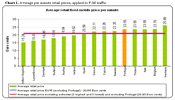
(click here to see the full-size image)
2. The retail prices represent the associated values of, on the one hand, the call termination cost on mobile operator networks, and on the other, the amount retained by the fixed operator (based on analysis of PT Comunicações, S.A. - PTC).
3. ANACOM established, by its determination of 25 February 20052, regarding the obligation to control prices in voice call termination wholesale markets on individual mobile networks, the termination price evolution to which mobile operators are bound, for the period of March 2005 to December 2006 (in accordance with the table below).
| Figures in Euro cents | Fixed-Mobile Termination | International-Mobile Termination (all operators) | Mobile-Mobile Termination (all operators) | |
| TMN and Vodafone | Optimus | |||
| Current price | 18.50 | 27.79 | 18.70 | 18.50 |
| 7 March 2005 | 14.00 | 20.50 | 14.00 | 14.00 |
| 1 July 2005 | 13.50 | 19.50 | 13.50 | 13.50 |
| 1 October 2005 | 13.00 | 18.20 | 13.00 | 13.00 |
| 1 January 2006 | 12.50 | 17.00 | 12.50 | 12.50 |
| 1 April 2006 | 12.00 | 15.00 | 12.00 | 12.00 |
| 1 July 2006 | 11.50 | 13.00 | 11.50 | 11.50 |
| 1 October 2006 | 11.00 | 11.00 | 11.00 | 11.00 |
4. Between 7 March 2005 and 1 July 2005, the average termination figure corresponds to approximately 15 Euro cents (14 Euro cents per minute for TMN and Vodafone and 20.5 Euro cents per minute for Optimus3), which is approximately 64% of the F-M retail tariff introduced on 11 May 20054.
5. The average PTC retained figure F-M5 traffic implicit in the tariff introduced on 11 May 2005 amounts to 8.55 Euro cents, representing 36% of the retail price.
6. ANACOM’s determination dated 14 December 2004, in relation to the application of obligations in the narrowband6 retail markets, established that, with regard to calls originating from a fixed network destined for a mobile network, the obligation to direct prices towards costs and to maintain prices accessible should be implemented with rates that are reasonable; such that, rates applied to the end user would also be reasonable, obliging PT Comunicações, S.A. (PTC) to reflect the determined evolution of F-M termination prices in the practiced retail rates.
7. As stated in the deliberation of 9 May 20057, regarding PTC’s fixed-mobile retail tariffs, any other ICP-ANACOM measures relating to PTC F-M traffic retention amounts that may be deemed necessary, in line with regulatory principles and an eventual alteration of the tariff structure, have not been prejudiced.
B. Analysis
B.1. Orientation of retention value towards costs
8. Based on PTC’s management accounting system results for 2002 and 2003, and for the 1st half of 20048, an analysis was performed on the evolution of total costs, unit costs and F-M traffic quantities. The data for the years 2005 and 2006 were estimated using the unit9 cost estimates and assuming that the traffic volumes would vary in accordance with the change seen in the previous year (annual reduction of 8.3%10).
9. The charts below summarize the resulting analysis, showing the steady decline in the number of minutes of F-M traffic from 2002 to 2006, with an estimated total reduction of approximately 30% over this period.
Chart II. Total and unit costs evolution associated with F-M traffic (2002-2006)
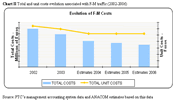
(click here to see the full-size image)
Source: PTC’s management accounting system data and ANACOM estimates based on this data
Chart III. Evolution of quantities associated with F-M traffic (2002-2006)
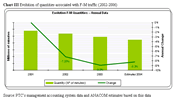
(click here to see the full-size image)
Source: PTC’s management accounting system data and ANACOM estimates based on this data
10. Given that PTC’s management accounting system results present, as of 2002, a clear representation of the costs associated with “operator remuneration”11, the group of the other cost components constitute an appropriate base of comparison for PTC retention on F-M traffic. The values associated with 2002 and 2003, as well as the estimates for 2004 (based on the management accounting system’s results for 1st half 2004), 2005 and 2006 (assuming the costs identified in 1st half 2004 are maintained), excluding the “operator remuneration” component, are summarized in the following table.
Table 2. PTC’s unit costs associated with traffic for mobile operators [CONFIDENTIAL]
Source: PTC’s management accounting system data
11. Based on the results presented in the preceding table, the estimated value of unit costs, excluding the “operator remuneration” component, for 2005 and 2006 is [CONFIDENTIAL], which results from the maintenance of values identified in 1st Semester 2004, considering that, as previously mentioned, the estimated values may represent a decline greater than that which actually occurred. The following chart illustrates the expected evolution.
Chart IV. Evolution of PTC’s unit costs associated with traffic for mobile operators (excluding the “operator remuneration” component [CONFIDENTIAL])
Source: PTC’s management accounting system data and ANACOM estimates based on normally adopted assumptions
B.2. International comparisons
12. As previously mentioned, the average retail price applied to F-M traffic, resulting from the tariffs introduced on 11 May 2005, is approximately 14.1% higher than the European average (EU 15, excluding Portugal).
13. A comparison of average retention12 figures in Europe follows. In the absence of specific information regarding F-M traffic profiles for each mobile operator, in each country, the information provided by PTC relative to the situation in Portugal is considered to represent a proxy for traffic occurring in other Member States13.
14. The comparison of the figures retained by the fixed operator on F-M traffic, in a EU 15 context, permits us to gauge the reasonability of the retention figure and, indirectly, the prices. The following chart summarizes the results, in terms of average retention values for each EU 15 country.
Chart V. Average retention per minute for F-M traffic in 2005
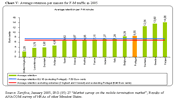
(click here to see the full-size image)
Source: Tarifica, January 2005; IRG (05) 27 “Market survey on the mobile termination market”; Results of ANACOM survey of NRAs of other Member States.
15. The comparison between the retention value per minute provided by PTC and those of the historic operators in the EU, shows that the average retention of 8.55 Euro cents per minute earned by PTC is higher than the EU average by approximately 13.6% (see chart below).
Chart VI. Variations in relation to the European average
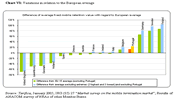
(click here to see the full-size image)
Source: Tarifica, January 2005; IRG (05) 27 “Market survey on the mobile termination market”; Results of ANACOM survey of NRAs of other Member States.
16. Note that if exclude the countries with the 3 highest and 3 lowest average retention amounts from the analysis, in order to remove the effect of extreme average values, the average retention amount for Europe (EU 15, excluding Portugal) is approximately 6.90 Euro cents, with Portugal having a retention value 23.9% higher than this average.
17. It should also be noted that the average retention value for the EU 15 is expected to decrease in the near future, due to the application of regulatory measures in a number of Member States. (For example, note the fact that tariffs for F-M calls in Spain and Holland are being regulated through their inclusion in a service package, whose average price is controlled by the respective NRAs; and that in Italy, there exists a price-cap on F-M calls of the Consumer Price Index - 6%14).
18. It is therefore justified that the downward trend in retail price retention applied to fixed-mobile traffic, resulting from the reduction of terminations established in the determination of 25 February 2005, should be reinforced with a reduction in retention amounts. It is also justified that, similarly to what occurred with termination prices, the initial decrease in retention should be greater than the subsequent reductions.
C. Conclusion and draft decision
19. The average retention amount, per minute, of PTC, in accordance with the tariff introduced on 11 May 2005, is about 14% higher than the European average.
20. Regarding the move to approximate PTC’s retention amount to costs, it is concluded that the former figure, resulting from PTC’s retail tariff for F-M traffic, is significantly higher than estimated costs for 2005.
21. It is therefore justified that the reduction of retail prices for F-M traffic, resulting from the termination reduction determined by ANACOM on 25 February 2005, should be accompanied by a decrease in the retention amount.
In view of the foregoing, in the scope of its jurisdiction provided for in Article 6, Item 1, Sections b), f) and h) of the articles of association, approved by Decree Law no. 309/2001 of 7 December, and in accordance with the regulatory objectives provided for in Article 5, Item 1, Sections a) and c), and Item 2, Sections a) and b), of Law no. 5/2004 of 10 February, the Board of Directors of ICP-ANACOM, in the application of the determination of 14 December 2004 regarding the application of obligations in the narrowband retail markets, hereby determines the following:
1. To instruct PTC to gradually reduce the retention amount relating to F-M traffic, in order to approximate this value to costs and to current European practices, in accordance with the following timetable:
| Average values | ||
| Estimated average retention | Change in retention | |
| May 2005 | 8.55 | - |
| 1 October 2005 | 7.55 | -1.00 |
| 1 January 2006 | 7.35 | -0.20 |
| 1 April 2006 | 7.15 | -0.20 |
| 1 July 2006 | 6.95 | -0.20 |
| 1 October 2006 | 6.75 | -0.20 |
2. The degree of the retention amount’s approximation towards costs will be reviewed in 2007, without prejudice to any additional interventions regarding this matter that this Authority considers to be appropriate and opportune:
3. To submit points 1 and 2 of this determination to a prior hearing of interested parties, under the terms provided for in Articles 100 and 101 of the Code of Administrative Procedures, and to establish a period of 20 working days in which these parties can voice their opinions, in writing.
1 ANACOM estimates, based on data obtained from January 2005 Tarifica publications and on the results of an ANACOM survey of NRAs (National Regulatory Authorities) of other Member States. For Portugal, the price in force, resulting for the tariffs introduced 11 May 2005, was considered.
2 See Wholesale markets for voice call termination in individual mobile networks (market 16)https://www.anacom.pt/render.jsp?contentId=419779.
3 Figures resulting from the tariffs defined by ANACOM to be in force between 7 March 2005 and 1 July 2005.
4 Estimated figures based on the F-M retail tariff introduced by PTC on 11 May 2005, after ICP-ANACOM’s non-opposition to the tariff proposal for fixed-mobile calls presented by PTC, in its deliberation of 9 May 2005 - see PT Comunicações fixed-mobile retail tariffhttps://www.anacom.pt/render.jsp?contentId=419201.
5 Note that the average retention figure, per minute, varies with the call duration given that there is no correspondence between the tariff structure adopted by PTC in retail (billed by the second after the first minute) and the structure adopted by the mobile operators (billed by the second from the first second).
6 See Imposition of obligations of narrowband retail marketshttps://www.anacom.pt/render.jsp?contentId=419637.
7 See PT Comunicações fixed-mobile retail tariffhttps://www.anacom.pt/render.jsp?contentId=419201.
8 Assuming the figures for 2004 are double those indicated for the first semester.
9 The maintenance of individual costs for 2004 was assumed, given that the resulting decline in direct costs and groups of individual costs of approximately [CONFIDENTIAL] in relation to the previous year’s results, according to PTC, may be greater than that which actually occurred. This because there exists the possibility that costs associated with sales may not be correctly allocated in the cost accounting system results for 1st Semester 2004, a fact PTC communicated by a letter dated 11 April 2005 (ANACOM receipt reference E11992/2005).
10 Note that this approach does not consider any possible increase in traffic resulting from the elasticity associated with the tariff alterations for F-M traffic.
11 Resulting from the fact that the alteration of the ownership of fixed-mobile traffic only occurred in October 2000.
12 By a non-parametric estimate, based on the breakdown of the distribution of call durations.
13 It was considered that the PTC-mobile operator traffic (TMN, Vodafone and Optimus) constituted an approximation of the traffic between the historic operator in each country and the three largest mobile operators (calculation based on information regarding market share in terms of number of subscribers of each operator).
14 Information obtained through an ANACOM survey of the NRAs of other Member States.




